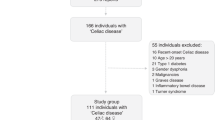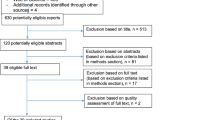Abstract
Background/Objectives:
Routine clinical care for Crohn’s disease (CD) outpatients does not cover the assessment of body composition (BC); although this disease (because of inflammation, surgeries, lack of physical activity and appetite) may have a severe impact on lean body mass. The main aims of this prospective research were to assess the nutritional status of the patients and to compare their data with apparently healthy gender- and age-specific matched control pairs.
Subjects/Methods:
Overall, 136 CD patients and 1752 apparently healthy people were involved in the study. All participants were measured by the same bioelectrical impedance analyser.
Results:
Using body mass index (BMI) and fat-free mass index (FFMI) as the markers of nutritional status, we found low BMI for 21% of the patients and low FFMI for 30% of them. Low BMI values were not gender specific, but substantially more females had low FFMI values. Low BMI was diagnosed in the patients’ vs the control group for 21 vs 4% for men and 21 vs 2% for women; whereas low FFMI was diagnosed for 25 vs 5% for men and 36 vs 14% for women. Significant differences were found between patients’ and control groups (median BMI: 22.0 vs 25.1 kg/m2, P<0.0001; FFMI: 17.3 vs 18.4 kg/m2, P=0.0044).
Conclusions:
This study confirmed the higher prevalence of low FFMI than that of low BMI among the subjects. We recommend implementing the assessment of BC into routine clinical care to diagnose low FFMI and to start intervention in time.
This is a preview of subscription content, access via your institution
Access options
Subscribe to this journal
Receive 12 print issues and online access
$259.00 per year
only $21.58 per issue
Buy this article
- Purchase on Springer Link
- Instant access to full article PDF
Prices may be subject to local taxes which are calculated during checkout


Similar content being viewed by others
References
Triantafillidis JK, Vagianos C, Papalois AE . The role of enteral nutrition in patients with inflammatory bowel disease: current aspects. BioMed Res Int 2015; 2015: 197167.
Bryant RV, Trott MJ, Bartholomeusz FD, Andrews JM . Systematic review: body composition in adults with inflammatory bowel disease. Aliment Pharmacol Ther 2013; 38: 213–225.
Sandhu A, Mosli M, Yan B, Wu T, Gregor J, Chande N et al. Self-screening for malnutrition risk in outpatient inflammatory bowel disease patients using the malnutrition universal screening tool (MUST). JPEN J Parenter Enteral Nutr 2016; 40: 507–510.
Mijac DD, Jankovic GL, Jorga J, Krstic MN . Nutritional status in patients with active inflammatory bowel disease: prevalence of malnutrition and methods for routine nutritional assessment. Eur J Intern Med 2010; 21: 315–319.
Massironi S, Rossi RE, Cavalcoli FA, Della Valle S, Fraquelli M, Conte D . Nutritional deficiencies in inflammatory bowel disease: therapeutic approaches. Clin Nutr 2013; 32: 904–910.
Aghdassi E, Wendland BE, Stapleton M, Raman M, Allard JP . Adequacy of nutritional intake in a Canadian population of patients with Crohn's disease. J Am Diet Assoc 2007; 107: 1575–1580.
Kondrup J, Allison SP, Elia M, Vellas B, Plauth M . ESPEN guidelines for nutrition screening 2002. Clin Nutr 2003; 22: 415–421.
Joan G (ed). Manual of Dietetic Practice. 5th ed. Wiley Blackwell: West Sussex, UK, 2014, pp 47–60.
Thibault R, Genton L, Pichard C . Body composition: why, when and for who? Clin Nutr 2012; 31: 435–447.
Biolo G, Cederholm T, Muscaritoli M . Muscle contractile and metabolic dysfunction is a common feature of sarcopenia of aging and chronic diseases: from sarcopenic obesity to cachexia. Clin Nutr 2014; 33: 737–748.
Leslie WD, Miller N, Rogala L, Bernstein CN . Body mass and composition affect bone density in recently diagnosed inflammatory bowel disease: the Manitoba IBD Cohort Study. Inflamm Bowel Dis 2009; 15: 39–46.
Bryant RV, Ooi S, Schultz CG, Goess C, Grafton R, Hughes J et al. Low muscle mass and sarcopenia: common and predictive of osteopenia in inflammatory bowel disease. Aliment Pharmacol Ther 2015; 41: 895–906.
Satsangi J, Silverberg MS, Vermeire S, Colombel JF . The Montreal classification of inflammatory bowel disease: controversies, consensus, and implications. Gut 2006; 55: 749–753.
Evans WJ, Morley JE, Argiles J, Bales C, Baracos V, Guttridge D et al. Cachexia: a new definition. Clin Nutr 2008; 27: 793–799.
Fearon K, Strasser F, Anker SD, Bosaeus I, Bruera E, Fainsinger RL et al. Definition and classification of cancer cachexia: an international consensus. Lancet Oncol 2011; 12: 489–495.
Aandstad A, Holtberget K, Hageberg R, Holme I, Anderssen SA . Validity and reliability of bioelectrical impedance analysis and skinfold thickness in predicting body fat in military personnel. Mil Med 2014; 179: 208–217.
Cederholm T, Bosaeus I, Barazzoni R, Bauer J, Van Gossum A, Klek S et al. Diagnostic criteria for malnutrition - An ESPEN Consensus Statement. Clin Nutr 2015; 34: 335–340.
Schutz Y, Kyle UU, Pichard C . Fat-free mass index and fat mass index percentiles in Caucasians aged 18-98 y. Int J Obes Relat Metab Disord 2002; 26: 953–960.
Cederholm T, Barazzoni R, Austin P, Ballmer P, Biolo G, Bischoff SC et al. ESPEN guidelines on definitions and terminology of clinical nutrition. Clin Nutr 2017; 36: 49–64.
Soeters P, Bozzetti F, Cynober L, Forbes A, Shenkin A, Sobotka L . Defining malnutrition: a plea to rethink. Clin Nutr 2017; 36: 896–901.
Zhou J, Liu B, Liang C, Li Y, Song YH . Cytokine signaling in skeletal muscle wasting. Trends Endocrinol Metab 2016; 27: 335–347.
Kyle UG, Schutz Y, Dupertuis YM, Pichard C . Body composition interpretation. Contributions of the fat-free mass index and the body fat mass index. Nutrition 2003; 19: 597–604.
Franssen FM, Rutten EP, Groenen MT, Vanfleteren LE, Wouters EF, Spruit MA . New reference values for body composition by bioelectrical impedance analysis in the general population: results from the UK Biobank. J Am Med Dir Assoc 2014; 15: e441–e446.
Forbes A . Crohn's disease: rehabilitation after resection. Dig Dis 2014; 32: 395–398.
Acknowledgements
We would like to express our thanks to Sarolta Dakó, Zsolt Mátyás Piri, Balázs Katona providing help in data collection, and to William Gesztes for providing language help as a native English speaker. None of the authors receive funding for this study. The authors do not have a relationship with the manufacturers of BC analysers and did not receive funding to conduct this research.
Author contributions
AM was responsible for study concept, design, assembly, measuring the patients with body composition analyser, data collection, data interpretation and writing the manuscript. ÁACs was responsible for study concept, design, assembly, data collection, interpretation and writing the manuscript. IK was responsible for measuring the apparently healthy subjects with body composition analyser, data collection. ÁDA was responsible for data cleaning, analysis and interpretation. EP was responsible for study concept and data interpretation. MP was responsible for study concept, assembly, data interpretation and approved the final version of the manuscript.
Author information
Authors and Affiliations
Corresponding author
Ethics declarations
Competing interests
The authors declare no conflict of interest.
Rights and permissions
About this article
Cite this article
Molnár, A., Csontos, Á., Kovács, I. et al. Body composition assessment of Crohn’s outpatients and comparison with gender- and age-specific multiple matched control pairs. Eur J Clin Nutr 71, 1246–1250 (2017). https://doi.org/10.1038/ejcn.2017.99
Received:
Revised:
Accepted:
Published:
Issue Date:
DOI: https://doi.org/10.1038/ejcn.2017.99



